Learning to read is more than just an essential life skill, it opens up entirely new worlds and possibilities.
However, as we all know, it is an area of learning which can be challenging.
For some children, this can mean stress, anxiety and difficulties progressing academically.
Research shows us that poor literacy skills are linked with low self-esteem and an increased risk of poor educational and social outcomes.
Conversely, early readers who develop strong literacy skills in their foundational years have been shown to thrive academically as they grow while also developing better self-esteem.
So how can we better support children to develop a firm foundation in literacy?
Thankfully, alongside research or evidence-based teaching methods, there is an ever-increasing number of resources aimed at improving literacy levels during these formative school years.
One of these proven resources is decodable reading books.
In this article, we’ll be outlining:
- What are decodable reading books?
- How they compare to other reading books
- What to look for in decodable reading books
- How to use them and where to find them
Let’s get into it…
What Are Decodable Reading Books?
Decodable reading books have been developed in line with the Structured Synthetic Phonics (SSP) method of teaching reading.
This method encourages learning through the recognition of letters (graphemes) and their associated sounds (phonemes).
This helps learners ‘decode’ text by breaking down words into smaller units of sound for easier comprehension.
By focusing on letters and sounds, decodable readers support the learners developing knowledge of phonics by encouraging them to sound out words using the SSP decoding strategy.
The idea is, that if you can break any word down into recognisable sounds, you can more easily read a broader range of words within text whether you have come across that word before or not.
These decodable readers differ from other types of levelled readers in that they teach children to focus on reading the words on a page rather than simply guessing or predicting what the text is based on imagery or other cues on the page.
Decodable texts are sequential and gradually build on a student’s phonics knowledge, they minimise the use of unknown words, instead focusing on grapheme-phoneme correspondence.
Tricky Words
Alongside the use of decodable reading books in Australian classrooms, the common to introduce ‘tricky words’, ‘sight words’ or as PLD refers to them; ‘high frequency words’..
This is because as a child reads they are likely to come across words that are significantly more advanced than the level of code they have learnt or that they are irregular words that are difficult to sound.
These more advanced, high-frequency words are introduced, explained and decoded with the support of the child’s teacher.
Examples of irregular/tricky words include ‘you’, ‘do’, ‘said’, ‘water’, ‘was’, ‘people’ and ‘one’.
The early introduction and practice of these ‘tricky words’ supports better fluency as the child progresses.
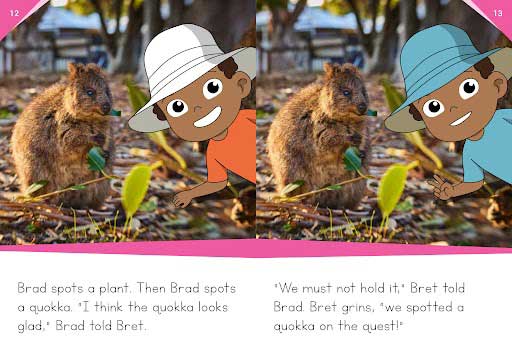
Decodable Vs Predictable Text
One alternative to decodable books that are often seen in a school setting are predictable texts.
These graded readers are often problematic in teaching foundational reading skills for many reasons.
Where decodables encourage children to break words down and sound them out using their existing knowledge of phonemes and graphemes, predictable text allows for guesswork by supplying imagery that supports the text.
Of course, the issue with this is that guessing the words on a page, even if accurately done, is not teaching a child to read text or supporting the proper development of their vocabulary.
Additionally, as one teaching resource so accurately points out:
“Predictable books do not follow a scope and sequence of any kind – phonic or otherwise. While the syntax and sentence structures in predictable books are simple, there is no systematic approach to the vocabulary included.”
This makes learning and retaining the information much more challenging for those in the early stages of learning to read.
While they are both English readers, a predictable text provides children with no formula or process to follow whereby they can ‘decode’ the words on a page.
It is relying on the memorisation of whole words and guesswork to develop reading skills which is known to be much less effective as a teaching method.
They also frequently include words that are much more advanced than the learner’s vocabulary or reading skills allow for, again relying on them to guess the word rather than read and learn it properly.
This is why new method readers such as decodables are such a valuable resource.
Decodables support students to gradually master their decoding skills and progressively challenge them through a series of A to Z levelled readers.
By building on the child’s emerging skills for segmenting and blending, decodables facilitate the ability to recognise words quickly and easily.
This can help to eliminate the frustrations of learning to read and make it a more enjoyable experience overall and as we know a child that enjoys learning to read is much better placed to excel at learning.
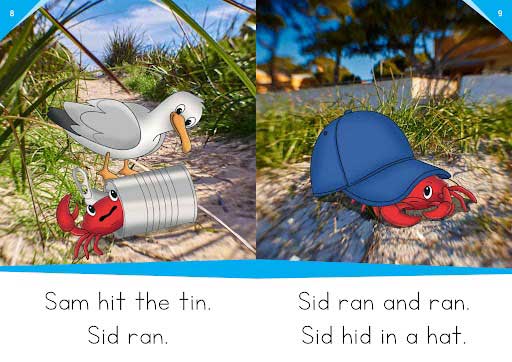
Why Are Decodable Books Important In A Child’s Vocabulary Development?
These types of books are beneficial as they supply children with essential opportunities to practise their phonics and decoding skills.
Understanding phonics is an essential step in children learning to master the written code for reading.
Once a child has mastered their early reading phonic knowledge, their vocabulary can develop more quickly as they can begin to move on to more complicated texts that incorporate a broader use of vocabulary.
The benefit of these types of books is that not only do they support the development of these decoding skills and advancement of vocabulary, but they are also designed to meet the reader at their level of comprehension.
Through the use of decodable books, children develop better accuracy and enjoy a more natural learning process which in turn supports greater fluency over time.
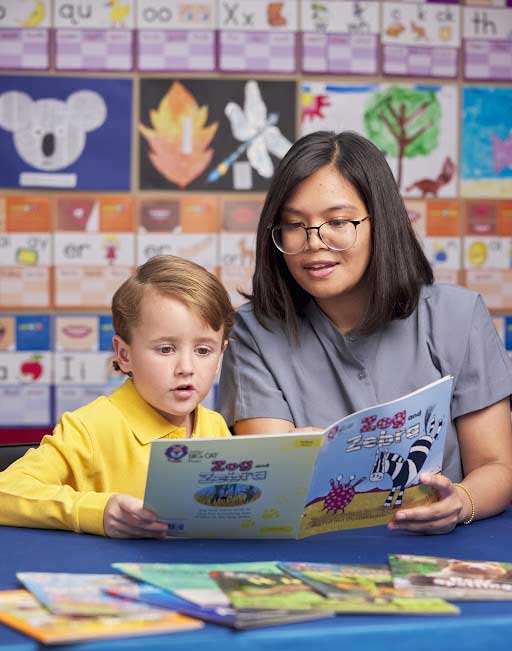
How Long Do Children Need To Read Decodable Reading Books?
How long children use decodables for will depend on their emerging skills. Decodables are suited to readers seeking to establish confidence in their early reading skills.
Usually, after around 18 months to 2 years of children reading decodable books they will have a firm grasp on their foundational reading skills.
At this time you may opt to diversify their reading material.
For children who are facing additional challenges with learning to read, continued use of these texts is recommended.
Who Benefits From Decodable Reading Material?
In short, all early readers! Decodable reading material is primarily used during the early stages of learning to read.
However, it is perfectly suitable for children in middle and upper primary years who are still reading at a junior primary level.
These texts are designed to support learners to build on their existing skills and students at a junior primary reading level can benefit from continuing to read decodables as a emans of accelerating their skills.
Once they are confident and able to read well, they are ready to move onto a wider range of reading books.
For teachers, decodables make it easier to introduce reading to children and supports their skills in decoding texts for more confident learners.
Comparing Decodable Text To Predictable Text
Whole Language or Balanced Literacy/Old school readers that follow a predictable and often repetitive text model are unfortunately still in active use within Australian schools.
This, combined with a lack of alignment in curriculums nationally, is part of why Australia’s literacy levels are below international averages.
It is also why so many children are struggling to learn to read.
Decodable texts should be the preferred resource within Australian curriculums for early learning.
Why?
As outlined above, predictable texts do not support genuine learning of vocabulary or ‘decoding’ skills for a text that phonics can achieve through decodable readers.
As teachers, supporting emergent readers to properly grasp the skill of reading is vital and sets them up for greater academic achievement throughout their lives.
This is not to say that decodables should be the only type of reading a child is exposed to during their formative learning years.
Children benefit from hearing unfamiliar words and more advanced syntax. This also helps them to become good readers at an early age.
These more advanced words and complex sentence structures, however, should be read to children by teachers and parents from an early age as part of their wider development of literacy skills.
Ultimately, the use of decodable readers has been linked with the emergence of more advanced or precocious readers.
These readers exhibit greater confidence in their skills, read with greater accuracy and often develop a lifelong love of reading.
What To Look For When Considering Decodable Books
So are all decodable types texts made equal?
The short answer is no.
There is a vast difference in quality between different brands of these books and some fall short of what we feel are minimum standards for quality text.
The best decodable readers are not necessarily the most expensive or most popular ones.
Before you select a new set of readers for your students, here are some tips to ensure you end up with good-quality decodable phonics readers:
- Ensure that the texts chosen have a sequence of grapheme-phoneme correspondences that are on the same level as the scope and sequence of phonics being implemented in the classroom or school as a whole.
- Make sure the decodables you choose complement the teaching methods for phonics at your institution.
- Decodables should have frequent use of the target grapheme-phoneme correspondences (GPC) being taught.
- Without consistent use of the GPC, it is harder for children to learn or make the connections between the grapheme-phoneme.
- Look for decodable text passages that incorporate proper use of grammar and punctuation as well as a natural continuous flow. This promotes more accurate and natural-sounding reading over time.
- An early readers series should limit text to one sentence per page with a progression to longer, more complex text as readers advance.
- The nominated tricky words for each level of text should be clearly outlined for teachers so these can be discussed and decoded with children ahead of reading.
- Tricky words should be kept to a minimum, at least in the early levels, the focus in this stage needs to remain on decoding using their knowledge of phonics rather than guessing or using other words in context.
Decodable Vs Levelled Books: What’s The Difference?
If you have utilised levelled readers in your classroom, you may be wondering what the difference is between these and decodable readers.
While both are designed to support early reading skills, they do have some key differences…
- The vast majority of levelled readers used in classrooms utilise predictive text whereas decodables use phonetically decodable text.
- Levelled readers as predictive text readers allow children to guess what text is based on the included pictures. A decodable text by comparison gives the child no choice but to sound out or decode the text using their understanding of phonics.
- Phonics-based readers revolve entirely around having children practise sounding out words and blending them. Levelled or free text readers are more about sentence length, word length, the number of words and how complex the story is. They do not include any work on phonics. They rely on the memorisation of whole words rather than combined sounds, which can be entirely more complex for many children to comprehend.
- Imagery in decodable early readers’ books is supportive of the story but doesn’t lead the child to guess the words in the same way imagery in predictive levelled texts does.
- Levelled readers (a-z) often include words that are not on par with the skill level of the child. This can lead to confusion or cognitive overload. In the decodable system texts introduce more complex words gradually to avoid this.
One of the biggest mistakes educational institutions make is using levelled readers while implementing a phonics-led method.
Why is this an issue?
Levelled books support the ‘whole word’ approach to teaching a child to read, whereas as we have outlined, decodable books support the phonics-led method.
How does this mistake happen in schools?
Often it is down to educators not understanding the differences between these readers as we have outlined above.
It can also happen because decodables are often viewed as boring or lacking in creativity due to minimal word use.
This is why it is important to invest in high-quality decodable home readers that incorporate interesting stories and imagery with targeted phonics practice.
Mixing decodable readers with predictive online levelled readers or books is to be avoided as this creates confusion and can inhibit the learning process.
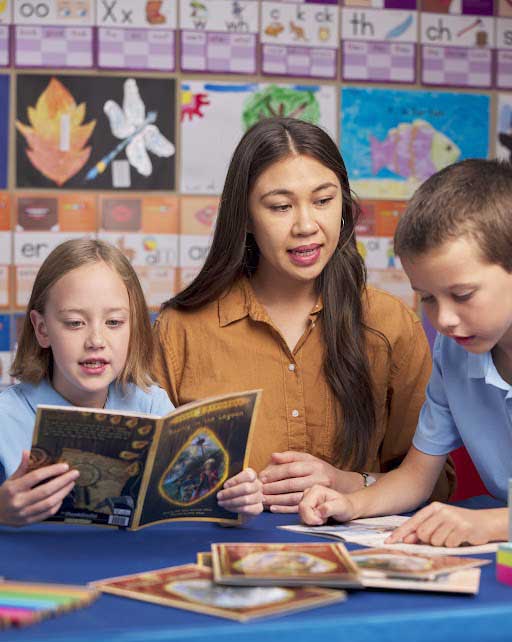
How To Use Decodable Books
How these types of texts are implemented in the classroom and used by teachers and students alike will depend on how phonics is being taught and the level of phonics knowledge the student already possesses.
In Australian schools, this could mean following the scope and sequence set out by evidence based, recommended reading programs such as PLD, Initialit or MultiLit.
Step 1:
The first step for how to properly use decodables is to choose the correct book.
Every decodable you pick up should contain specific letter-sound knowledge. This is most often found on the front inside cover of the book.
We do not generally recommend free printable decodable books for kindergarten/foundation learning as they will often leave this important information out. Should you opt to use these, please review their content carefully first.
You should select a book or series of books for the class that corresponds with the letter sound knowledge you are currently teaching or need to practise.
For example, if you are teaching long vowel sounds or specific letter sounds, you should only use books that feature these sounds.
Step 2:
The second step towards effectively using these texts is to practise blending newly learned sounds so students can read words found in the text featuring these sounds.
Learning sounds must always be combined with practising words featuring these sounds so that a more effective transfer of learning can be achieved.
This helps children see the purpose of learning the sounds.
Encourage children to read these blended sounds quickly without sounding out each sound as this promotes fluency and better demonstrates the purpose of sounds in the creation of a whole word.
Step 3:
Alongside the practising of new sounds, time must be taken to introduce the tricky words.
These are usually outlined either inside the front or rear cover of the book.
Have students practise these words and say them as fast as they can as this will also aid in fluency while reading the book.
Step 4:
While reading, it can be helpful to encourage preschool readers or early primary students to point to words and move their fingers along the page.
This aids in blending sounds and helps them keep track of their reading.
If an error is made, encourage your student to blend the sounds again, you may need to re-read some sentences out loud to your student to model the correct blending of the sounds and proper expression.
Have your student copy your reading and of course, encourage their efforts.
Step 5:
Decodable texts encourage students to respond to the text following reading to check for correct comprehension.
This could mean asking targeted questions relating to the story itself or more open-ended questions such as if they liked the book and their reasoning or what their favourite part was.
Assessing Progress
Ensuring your students are progressing as expected and understanding the material being taught is essential.
Most students will at some stage be asked to undergo a reading test which is then used to determine the type of decodable reading books presented to the child.
The PLD Approach
At PLD, we supply a range of screening and tracking manuals that supports teachers, educational assistants, support staff and parents to understand where a student is placed concerning their reading skills.
We provide clear instructions on how to assess, when and what to assess and how to interpret results.
You can find these invaluable resources for decodable readers online on our website where they are free to download.
Our screening and tracking process seeks to equip teachers with the necessary insights that allow them to modify their approach to teaching for more effective outcomes.
This is beneficial for one-on-one, small group and whole class teaching and learning.
How Long Do Children Typically Use Decodable Reading Books?
Decodable books are Introduced to junior primary students in their initial 18 months or two years of learning to read.
Once a child has established the skill of using knowledge of letter-sound relationships to make sense of unfamiliar words and demonstrates confidence in blending these sounds to read confidently, you can introduce more advanced natural language texts and a broader range of reading material into their learning.
The skills learned through decodable reading will ensure they are equipped to accurately, independently and successfully decode new words and progress with confidence in their reading.
For children facing difficulties learning to read, they can continue to utilise these texts as long as necessary.
At PLD we accommodate learning across a range of interests and age groups from early primary as well as middle and upper primary.
From themed Aussie decodable readers covering familiar topics to fun fantasy texts involving dragons and castles, there is a decodable text to appeal to every child.
Need decodable books for 2nd grade or higher?
We also offer a comprehensive catch-up series for older students requiring additional support.
The skills learned through decodable reading will ensure they are equipped to accurately, independently and successfully decode new words and progress with confidence in their reading.
For children facing difficulties learning to read, they can continue to utilise these texts as long as necessary.
At PLD we accommodate learning across a range of interests and age groups from early primary as well as middle and upper primary.
From themed Aussie decodable readers covering familiar topics to fun fantasy texts involving dragons and castles, there is a decodable text to appeal to every child.
Need decodable books for 2nd grade or higher?
We also offer a comprehensive catch-up series for older students requiring additional support.
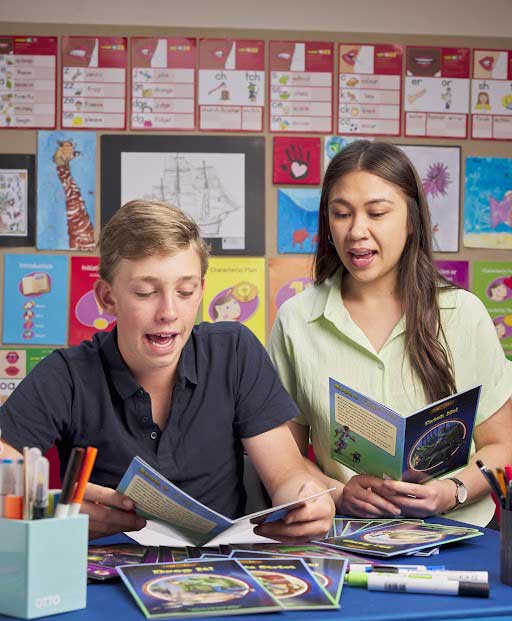
The Best Decodable Books For Kids
So which decodable readers do we recommend?
At PLD we have carefully curated a range of decodable readers from a variety of publishers that align with our evidence-based Structured Synthetic Phonics program.
All our decodable readers for use in both classroom and home settings can be purchased via our website.
For decodable readers in Australia, to complement our junior primary early decodable reading books, we also stock a range of others online on our website.
These include:
- Various Dandelion readers
- Moon Dog decodable readers
- Collins Big Cat Phonics readers
- The Dragon Eggs series
- The Magic Belt Series
- The Island Adventure Series
- The Totem Series
- The Alba Series
- Talisman decodable readers
- Titans Gauntlet Series
- Reaching Rockets
- Phonic UK
- Big Cat Phonics
- Snappy Sounds
- Various Fitzroy readers and more.
Our carefully selected home reading book sets and group reading book sets are chosen to suit a variety of skill levels and ages and are a mixture of both fiction and nonfiction readers.
We also offer CVC readers, CCVC and CVCC readers that blend word patterns.
These are split into developmental reading levels for the beginning readers, readers in Year 1 & 2 that are struggling and older students who also are struggling to acquire basic reading skills.
Why Does PLD Collaborate With SPELD?
SPELD is a not-for-profit organisation that supports people with learning difficulties across several states in Australia.
SPELD supports training for most evidence based SSP programs in Australia.
Fees collected by PLD from these seminars are donated directly to SPELD towards the continuation of their vital work.
They offer a range of resources for professional development in teachers as well as guidance on how to best support learning in those with additional challenges.
SPELD SA also offers some free decodable readers in Australia for online learning.
Many of SPELD’s online readers are indigenous stories that allow children to connect with Country and learn about contemporary indigenous and community stories.
How does PLD assist with decodable reading books for teachers, parents or both?
PLD-literacy.org works with school Teachers, assisting with their professional development by offering resources and training to improve the literacy levels of students in classrooms.
Resources and support for home schooling parents is also available on our website.
PLD provides teachers with resources for them to provide to parents as PLD believes the best literacy outcomes are achieved when teachers and parents work together.
We also recognise that learning should be fun and engaging, which is why our carefully curated range is increasingly popular as a learning resource.
Through online or in-person seminars, targeted training, easy-to-follow guides and a wealth of free, downloadable resources, we make it easier for teachers to use decodable readers.
There is even the option for free coaching or Q&A sessions as needed.
FAQs
Can Teachers Mix Different Brands Of Decodables?
There is no hard and fast rule about having to stick with only one type of decodable book, however, it is important that you are using books that are compatible with your phonic reading sequence.
At PLD we mix Dandelion decodable readers amongst other curated sets mentioned above for a diverse and engaging collection.
When selecting decodables, the important thing is to ensure that the book you are using or sending home for reading matches the scope and sequence you are currently teaching.
If your school has some decodables already such as:
- Jolly Phonics decodable readers
- Sounds Write decodable readers
- Wushka decodable readers
These may still be able to be used alongside our readers.
Be sure to check the inside covers of all books and note their content to ensure they do not conflict with your teaching.
Are There Any Free Decodable Readers In Australia Online?
Yes, SPELD SA decodable readers are available via their website in limited numbers.
Using early readers online is discouraged because being able to hold and touch the book as they read can assist in keeping children focused and engaged with the text.
This is why it’s highly recommended to have children read physical books as much as possible during their early years.
Additionally, as mentioned above, many online reading books, free or otherwise, may not be at the appropriate level for your child.
Can We Still Utilise Levelled Readers?
No, as outlined earlier, levelled readers are incompatible with the decodable phonic readers approach to reading or learning to read and as such should not be used.
You can read more about this incompatibility here on our related blog topic.
Instead of levelled readers for older children such as:
- McMillan readers
- Pearson graded readers
- Graded readers by Oxford (OUP readers)
- All Star readers
- Penguin Happy Readers
- PM Library
We recommend our easy readers books in our catch up series. We stock a range of Phonic UK books which can be accessed here.
Wrapping Up
PLD is passionate about the provision of quality decodable readers for children, readers that are fun, engaging and supportive of learning.
Whether through the use of decodable readers in their classrooms or in guiding parents through how to use them at home, PLD is dedicated to supporting teachers to achieve enhanced literacy levels in children Australia-wide.
Our ever-evolving range of decodables has seen us become a leader in our field.
For decodable texts free of too many tricky and unknown words or those lacking in creativity, PLD is unmatched.
Foster a life-long love of learning in your students and support them to read more easily, more quickly and with greater confidence.
Contact our team today to learn more or to get started.



 print
print